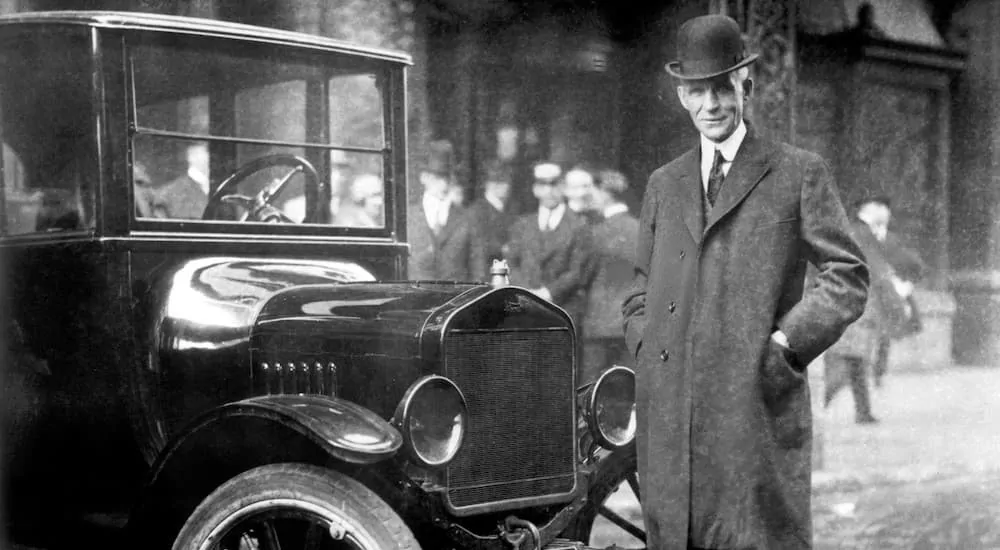When you think of local Ford Dealerships, you might not initially picture the long evolution of technology that led the automotive industry to where it is today. For much of our social history, collective efforts were born out of determination towards a common goal. The magnitude of human achievements like Stonehenge or the pyramids could never have been accomplished by an individual or even a small, organized group.
Monumental projects like these were not the focus of ordinary people. They were special organized efforts by leaders giving orders from the top down. Sociologists may wonder how regular people managed to live their lives, relying only on themselves or a small group for everything from tool-making, home building, food collection, and survival.
From Hunting and Gathering to Cottage Industry
In the past, tribes coordinated cohesive efforts to survive while hunting and gathering. Humans are social creatures who turn to teamwork in a variety of situations. As we moved into the realm of agriculture, many people became farmers, honing the science of cultivating crops. Once societies stabilized through an abundance of resources, cities cropped up, and workers began to specialize their skills.
For instance, a miller would run a small mill where townsfolk could come to process their grains, or a baker would operate a bakery where people would come to bake their bread. By medieval times, individual people didn’t have much within the confines of their small thatched houses. Instead, favoring the use of central communal facilities. Interestingly, the remnants of this society are still around. We can recognize the occupations of people’s ancestors through surnames, like Miller, Baker, Brewer, Thatcher, etc.
As time went on, specialization continued, growing into what were known as cottage industries. These were small-scale industrial affairs, often run out of someone’s home or cottage. Specialized businesses were effectively the first contractors. Craftsmen may get an order for 50 undershirts or 12 pairs of shoes or any number of specialty items. This system gave society access to a greater quantity and quality of goods. While handing down a family trade from generation to generation certainly had its perks, there was no way to produce massive amounts of goods because production was bottlenecked by the limits associated with handcrafted products.

The Evolution of Technology in the Industrial Revolution
Cottage industry practices remained a large part of human society for millennia. That is until the Industrial Revolution brought on abrupt changes to the way complex goods were produced. Nonetheless, the cottage industry isn’t necessarily gone entirely. Websites like Etsy, along with craft and art shows, are examples of the modern cottage industry.
However, after the Industrial Revolution, most manufacturing was scaled up due to tremendous advances in technology. While some small groups like the Luddites resisted and even attempted to destroy the towers of mass production in protest, factories marched on and persevered. Comford Mills is noted as the birthplace of the modern factory.
Richard Arkwright patented the spinning frame in 1769. The spinning frame was a spinning frame used in textile production powered by water. Since modern fuel sources were unavailable, water mills were used, harnessing the natural power of flowing rivers. Multiple frames could be fueled by one water source, exceeding the production potential of human-powered devices exponentially. Much early factory development was based around textile production but laid the foundations for later factories in other industries.
Modern Industrial Advances Continued
Beyond the establishment of factories, one of the most progressive technological advances was locating a power source that was not reliant on nature. Water from rivers and streams had been sufficient for small scale factories, but as operations grew, so too grew the need for robust and more readily available power.
The concept of steam engines had been around since 1698 but wasn’t yet being harnessed as a useful item. The first piston-pump based steam engine came by way of Thomas Newcomen in 1712, but it didn’t become a factory staple until James Watt made significant improvements in 1765. These included adding a separate condenser to keep the cylinder hot. Watt continued to improve upon the steam engine by making it double acting, reorienting the gearing, and adding a centrifugal governor for constant speed.
Progress continued forward and was bolstered by the development of fuels for combustion-based power. This upgrade blew water power away, mainly because it was much more powerful and consistent. Low water levels in a drought or rising waters in a flood were no longer of consequence. Also, starting with the Bridgewater Foundry, various implements were used to expand and exceed the limitations of human capability. Innovations, such as cranes for lifting heavy objects, became commonplace. Arguably, the most critical advance in the modern era came from Henry Ford himself.
Henry Ford’s Moving Assembly Line
While we take it for granted today, the assembly line was once just the dream of a visionary. By 1913, when Ford first utilized the moving assembly line, factories were everywhere and provided many of the goods used around the world. However, factories were still limited by the scale at which they could produce goods. Assembly lines allowed for mass production by assigning workers to specific roles. Before the assembly line, workers had to shift into different jobs throughout the factory. This versatility came with the added cost of inefficiency, causing hold-ups in production.
Ford’s set-up was designed to produce automobiles, namely the Model-T. Ford was an engineer by trade and started his career with the Edison Illuminating Company of Detroit. He had a stellar career and was eventually promoted to chief engineer. While working for Edison Illuminating, Ford had much bigger dreams. He was captivated by gasoline engines, which could provide many times the power of any other engine available at the time.
Ford was determined to make a self-propelled vehicle, which he was able to do by 1896. This vehicle was known as the Ford Quadricycle. It looked like a carriage with four bicycle wheels. The Ford Quadricycle’s two-cylinder engine design could only produce a meager 4 hp, but Ford was on the brink of great innovation.
Success didn’t come easy. Ford’s first foray into producing his vehicles on a larger scale was a flop. The cars made by his Detroit Automobile Company ended up being overpriced and poorly made. His second attempt came after the creation of a 26 hp racing car in 1901. Stockholders from Ford’s initial company went on to form the Henry Ford Company later that same year.
After a few more company iterations and car designs, the most well known of Ford’s automobiles was born. The Model-T was one of the world’s first mass-produced vehicles, again thanks to the innovative assembly line. The Model-T was sold for an affordable $825, which is equivalent to around $23,500 today. It was a smash hit at the time and continues to be the reason Ford remains in our collective minds as one of the most successful car companies to date.
Remembering Our Long Road to Success
The next time you’re browsing the latest Ford models or watching an impressive new car commercial, remember how much innovation and time it took for humans to make it to where we are today. From hunters and gatherers to large-scale efforts run by top-down dictators, carefully curated cottage industries, and ultimately Ford’s moving assembly line, humans have never stopped racing towards efficiency and innovation.





